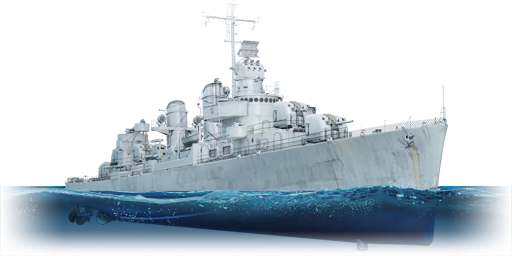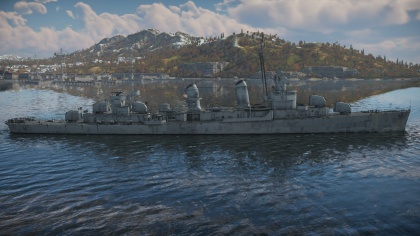USS Fletcher
Contents
Description
The Fletcher-class, USS Fletcher (DD-445), 1942 is a rank II American destroyer
with a battle rating of 4.7 (AB/RB/SB). It was introduced in Update 1.79 "Project X" as part of the fleet closed beta test.
General info
Survivability and armour
Talk about the vehicle's armour. Note the most well-defended and most vulnerable zones, e.g. the ammo magazine. Evaluate the composition of components and assemblies responsible for movement and manoeuvrability. Evaluate the survivability of the primary and secondary armament separately. Don't forget to mention the size of the crew, which plays an important role in fleet mechanics. Tips for preserving survivability should be saved for the "Use in battle" section.
If necessary, use a graphic template to show the most well-protected or most vulnerable points in the armour.
Mobility
Write about the ship’s mobility. Evaluate its power and manoeuvrability, rudder rerouting speed, stopping speed at full tilt, with its maximum forward speed and reverse speed.
Armament
Primary armament
The Fletcher carries a rather powerful main armament and is a step up from the preceding Farragut. Armed with 5 x single 5"/38 Mark 12 dual-purpose guns which fire faster than before, the Fletcher can easily gun down opponents provided the captain aims accurately. The arrangement of the guns is essentially the same as found on the Farragut, however, an extra gun is placed behind the torpedo tubes, but is facing forward. With a maximum of 22 rounds per minute (just under 3 second reload time) the cannons are able to put out a large amount of damage, but the shells do still retain the lofty trajectory at longer ranges. Once within around 7,000 meters, it will much easier to hit a target and deal consistent damage.
Fletcher uses the same ammunition as the earlier ships, with the AAC Mark 34 shell being the default. Available for upgrade is the Common Mark 32 SAP shell and the AAVT Mark 31 HE-VT shell. The VT shells are just as powerful as before and having 5 of them flying towards a target just further ensures that a hit could be critical or even lethal. Because of the rank where the Fletcher is situated, there is an increased chance of seeing the early light cruisers which can have formidable armour, so if you find yourself in need of some extra punch the SAP could be just what you need.
Secondary armament
The Fletcher has a secondary armament of a single twin 40 mm Bofors L/60 Mark 1 mount which is located in an elevated position in between the main guns near the aft section of the ship. This location provides a very wide arc of fire (-15 degrees/+88 degrees) along with clear vertical firing angles. This mount can be devastating if it hits an aircraft and can make short work of smaller torpedo boats which come in too close looking for a kill shot.
The 40 mm Bofors L/60 Mark 1 has three available belts:
- Universal: AP-T / HEFI-T / AP-T / HEFI-T
- HE: HEFI-T / HEFI-T / HEFI-T / AP-T
- AP: AP-T / AP-T / AP-T / HEFI-T
Anti-aircraft armament
The anti-aircraft armament for Fletcher is 6 x 20 mm Oerlikon Mk.II cannons. These are spread along the ship with two of them being near the bridge and facing forward with the other four being on the main deck amidships which gives a balanced level of coverage. Combined with the 40 mm Bofors L/60, these can give a decent level of short range defense and can easily take out aircraft which stray by and fail to evade. These guns can also be the last line of defense against small boats if necessary.
The 20 mm Oerlikon Mk.II cannons on Fletcher come only with a Default belt:
- Default: HEF-T / AP-T / HEF-T / AP-T
Torpedo armament
The torpedo armament on Fletcher is 2 x quintuple launchers carrying the 21" (533 mm) Mk.15 torpedo. The launchers are amidships and grouped together, but the tight spaces mean that you do need to maneuver the ship a bit to launch the torpedoes at their intended targets. The standard setting for the torpedo is 5,500 meters at 45 knots and by using the Torpedo Mode upgrade it can be modified to 9,150 meters at 33.5 knots. A single hit on a ship from one of these torpedoes will either be severely crippling or outright destroy it. Having 10 torpedoes allows for a wide range saturation attack with the increased range, or a wall at closer ranges.
Special armament
After unlocking the Bomb Mortar upgrade, you have the option to equip 6 x Mk.6 mortar depth charges. With three on each side of the ship near the aft main battery mounts, this ship has more than the Farragut. These weapons have a very limited and short-range but can be highly destructive in a close-quarters duel if their deployment is timed correctly.
Usage in battles
Considered one of many strong destroyers on the American tech tree, the Fletcher is most effective in gunning down its targets and maintaining that pressure on enemy destroyers. With the 5 main cannons and its quick rate of fire, even if one of these cannons gets destroyed, it will still be able to maintain its fire power with the remaining four. Altogether giving enemies a hard time when they're in range. The most favored maps for the Fletcher will be maps that will have multiple island cover as you will be able to take advantage of your speed of 40 knots and decent turn speed to swiftly attack a target and escape if needed. The torpedoes come in handy by locking down choke-points and common paths for players, making a long range attacks on the AI ships in encounter games, or forcing enemy ships to dodge.
As for play style, it can be used for hit and runs against other enemy destroyers and PT Boats that are looking to capture objectives. When faced against cruisers, the Fletcher does have the rate of fire and shells to fight back. However, your anti-fragmentation armor will not be enough to prevent the powerful punch of large HE shells or AP shells that even early cruisers will use against you so it is highly advised to avoid larger ships.
Modules
| Tier | Seakeeping | Unsinkability | Firepower | |||
|---|---|---|---|---|---|---|
| I | Dry-Docking | Tool Set | 127 mm Common Mk.32 | 40 mm HE clips | Anti-Air Armament Targeting | |
| II | Rudder Replacement | Fire Protection System | Smokescreen | 40 mm AP clips | Auxiliary Armament Targeting | |
| III | Propeller Replacement | Ventilation | Shrapnel Protection | 127 mm AAVT Mk.31 | Improved Rangefinder | Primary Armament Targeting |
| IV | Engine Maintenance | New Pumps | Ammo Wetting | Torpedo Mode | Bomb mortar | |
Pros and cons
Pros:
- Main battery has a very high ROF and quick turret traverse
- VT shells are very effective against aircraft
- Single twin 40 mm Bofors provides decent defence against aircraft
- Decent speed and manoeuvrability
- Anti-frag armour provides moderate protection from splinters and near misses
Cons:
- No armour, direct hits will cause damage, just depends on how much
- Torpedo firing arcs are less effective
History
One of the most prolific ships during World War II 175 ships of the Fletcher-class destroyer was commissioned between 1942 and 1944. The designed proved so successful that it continued to serve into the Korean and Vietnam war.[1] The Fletcher class saw widespread use across the pacific theatre and was highly successful due to its long operational range and a high degree of flexibility that made it able to tackle almost any task.[1]
Being the first generation of ship designed after the collapse of the Washington and London Naval treaties, the Fletcher was designed to be larger and carry more armament than previous destroyers. Due to the increased threat of air targets, the fletcher was also given substantial Anti-Aircraft armaments, which became very useful against the Imperial Japanese Navy. [2]
During World War 2, nineteen Fletcher class destroyers were sunk while 6 were damaged to such a degree that repair was not carried out[3]
The last Fletcher Class destroyer was decommissioned in 2001 from the Mexican Navy, which gives it an impressive service record of almost 60 years.[3]
Media
See also
Links to the articles on the War Thunder Wiki that you think will be useful for the reader, for example:
- reference to the series of the ship;
- links to approximate analogues of other nations and research trees.
External links
Paste links to sources and external resources, such as:
- topic on the official game forum;
- encyclopedia page on ship;
- other literature.
References
- ↑ 1.0 1.1 Friedman, Norman. US Destroyers: An Illustrated Design History (revised edition, Naval Institute Press, Annapolis, 2004), pp.111-112.
- ↑ Friedman, Norman. US Destroyers: An Illustrated Design History (revised edition, Naval Institute Press, Annapolis, 2004), pp 117-119
- ↑ 3.0 3.1 Destroyer History Foundation. (n.d.). Fletcher Class - 2,100-ton destroyers in WWII. Retrieved October 2019, from http://destroyerhistory.org/fletcherclass/.
| USA destroyers | |
|---|---|
| Clemson-class | USS Welborn C. Wood · USS Barker · USS Litchfield |
| Farragut-class | USS Aylwin |
| Bagley-class | USS Bagley |
| Porter-class | USS Porter · USS Phelps · USS Moffett |
| Somers-class | USS Somers · USS Davis |
| Fletcher-class | USS Fletcher · USS Bennion · USS Cowell |
| Allen M. Sumner-class | USS Sumner |
| Gearing-class | USS Gearing · USS Frank Knox |
| Mitscher-class | USS Mitscher · USS Wilkinson |





